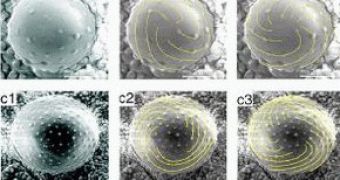The Fibonacci spirals and their occurrence in plants, from pinecones and pineapples to sunflowers, have always fascinated mathematicians, physicists and biologists, but they are still an enigma.
A new experiment has succeeded in producing Fibonacci spirals in the lab and points that an elastically mismatched bi-layer structure can induce stress patterns necessary for Fibonacci spirals emergence, a possible explanation for the widespread occurrence of the pattern in plants.
The Chinese team of the Zhejiang Sci-Tech University, the Institute of Physics in Beijing and the Chinese Academy of Sciences made their achievement by manipulating the stress on inorganic microstructures consisting in a silver core and a silicon dioxide shell.
This spontaneous assembly is hard to achieve in the laboratory and researchers have thought the plant patterns could be modelled by mutually repulsive entities of spherical or conical surfaces.
"We conjecture that the Fibonacci spirals are the configuration of least elastic energy. Our experimental results provide a vivid demonstration of this energy principle. This is the best support for this energy principle of phyllotaxis (or "leaf arrangement") before a rigorous mathematical proof is available." said co-author Zexian Cao, from the Chinese Academy of Sciences
The Fibonacci spirals curve around a surface in the "sinister" form (clockwise) or the "dexter" form (counterclockwise). The numbers of spirals are two consecutive ones from the Fibonacci sequence (1, 1, 2, 3, 5, 8, 13, etc.). The Chinese researchers made spirals of 3x5, 5x8, 8x13, and 13x21. As the microstructures were very minute, further series (21x34) would have needed over 700 "spherules", a stress too high for the structures to stand it.
Thermal stress engineering was applied on the elastically mismatched structure, made of a stiff layer on a compliant surface. The mix of SiO and Ag2O was heated at 997 degrees C, over the melting point of silver but under that of silicon dioxide, resulting the required elasticity difference. When the conical-shaped structures were brought to low temperatures, spherules emerged on the most stressed points, in Fibonacci spiral patterns, in both sinister and dexter forms.
Only the conical structures delivered Fibonacci spirals with definite chirality. The spherical forms transposed into triangular patterns, but the irregular conical shapes resulted in an 'X-pattern', like in a strawberry. These results explain the predominance of the natural conical surfaces that produce Fibonacci spirals.
"The least energy configuration for particles is dependent on the geometry of the space in which the particles are confined-just look at the thorn bundles of various cacti. I only know that the Fibonacci spiral patterns are not the least energy pattern for a sphere (try to imagine a football) or flat plane (we can make Fibonacci spirals on street pavement, but it is not self-assembled). However, Fibonacci spirals do appear on conical receptacles in nature. I conjecture that Fibonacci spirals are the least energy configuration on conical supports, but I cannot prove it." said Cao.
"There is no general method to find the least energy configuration for a given confining geometry, and the numerical solution costs enormous time of both the computers and the scientists. And numerical solutions would never be accepted as proof. A proof of problems of this kind needs new mathematics." added Cao.

 14 DAY TRIAL //
14 DAY TRIAL //